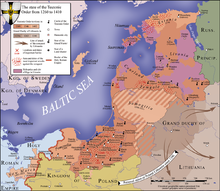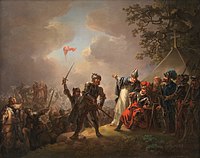Livonian Crusade
| Livonian Crusade | |
|---|---|
| Part of the Baltic States | |
| Result |
Crusader victory
|
| Territorial changes |
Creation of Duchy of Estonia
|
 Sword-Brothers
Sword-Brothers Livonian Order
Livonian Order Medieval Denmark
Medieval Denmark Duchy of Estonia
Duchy of Estonia Principality of Rügen
Principality of Rügen
 Bishopric of Riga
Bishopric of Riga Bishopric of Dorpat
Bishopric of Dorpat Sweden
Sweden- Tālava
 christianized Livs, Letts, Estonians, Latgalians and Ungannians
christianized Livs, Letts, Estonians, Latgalians and Ungannians Bishopric of Courland
Bishopric of Courland Bishopric of Ösel–Wiek
Bishopric of Ösel–Wiek
Baltic pagans (indigenous peoples)
| History of Estonia |
|---|
 |
| Chronology |
|
|
| History of Latvia |
|---|
  |
| Chronology |
|
|
The Livonian crusade
On 2 February 1207,[3] in the territories conquered, an ecclesiastical state called Terra Mariana was established as a principality of the Holy Roman Empire,[4] and proclaimed by Pope Innocent III in 1215 as a subject of the Holy See.[5] After the completion of the crusade, the Teutonic- and Danish-occupied territory was divided into six feudal principalities by William of Modena.
Wars against Livs and Latgalians (1198–1209)
By the time the first
The indigenous Livonians had often been under attack[6] by their southern neighbours, the Semigallians, who at first had considered the Saxons (Germans) to be useful allies. The first prominent Livonian to be converted was their leader Caupo of Turaida, who was baptized around 1189.
To avenge Berthold's defeat, Pope Innocent III issued a bull declaring a crusade against the Livonians. Albert von Buxthoeven, consecrated as a bishop in 1199, arrived the following year with a large force, and established
As the German grip tightened, the Livonians and their christened chief rebelled against the crusaders. Caupo's forces were defeated at Turaida in 1206, and the Livonians were declared to be converted. Caupo subsequently remained an ally of the crusaders until his death in the Battle of St. Matthew's Day in 1217.
By 1208 the important Daugava trading posts of
In 1209, Albert, leading the forces of the Order, captured the capital of the Latgalian Principality of Jersika, and took the wife of the ruler Visvaldis captive. Visvaldis was forced to submit his kingdom to Albert as a grant to the Archbishopric of Riga, and received back a portion of it as a fief. Tālava, by then already weakened in wars with its Finnic and East Slavic neighbours, became a vassal state of the Archbishopric of Riga in 1214, and was completely divided up between the Archbishopric and the Order in 1224.
-
Baltic tribes, c. 1200.
-
Lands of Tālava
-
Lands of Lotigola
Wars against Estonians (1208–27)
Conquest of the Estonian hinterland
By 1208 the Crusaders were strong enough to begin operations against the
In 1208–27, war parties of the different sides rampaged through Livonia, Latgalia, and northern Estonian counties, with the Livs, Latgalians and troops from the East Slavic
The Christian kingdoms of
During the uprising of 1223, all Christian strongholds in Estonia save Tallinn (Reval) fell into Estonian hands, with their defenders killed. By 1224, all of the larger fortresses were reconquered by the crusaders, except for
Early in 1224 Emperor
In 1224 the Livonian Brothers of the Sword established their headquarters at Fellin (Viljandi) in Sackalia, where the walls of the Master's castle are still standing. Other strongholds included Wenden (Cēsis), Segewold (Sigulda), and Ascheraden (Aizkraukle).
The
-
Counties of Ancient Estonia
-
Dannebrog falling from the sky during the Battle of Lindanise, 1219.
War against Saaremaa (1206–61)

The last Estonian county to hold out against the invaders was the island country of Saaremaa (Ösel), whose war fleets had continued to raid Denmark and Sweden during the years of fighting against the German crusaders.
In 1206, a Danish army led by the king
in Western Estonia. The Oeselians attacked the Swedish stronghold later the same year and killed the entire garrison, including the Bishop of Linköping.In 1222, the Danish king
In 1227, the Livonian Brothers of the Sword, the town of Riga, and the
After the defeat of the Livonian Brothers of the Sword in the
Warfare erupted in 1261 as the Oeselians once more renounced Christianity and killed all the Germans on the island. A peace treaty was signed after the united forces of the
On 24 July 1343 the Oeselians arose yet again, killing all the Germans on the island, drowning all the clerics, and besieging the Livonian Order's castle at Pöide. After the garrison surrendered the Oeselians massacred the defenders and destroyed the castle. In February 1344 Burchard von Dreileben led a campaign over the frozen sea to Saaremaa. The Oeselians' stronghold was conquered and their leader Vesse was hanged. In the early spring of 1345, the next campaign of the Livonian Order ended with a treaty mentioned in the Chronicle of Hermann von Wartberge and the Novgorod First Chronicle.
Saaremaa remained the vassal of the master of the Livonian Order and the Bishopric of Ösel-Wiek until 1559.
Wars against Curonians (1242–67)

Following the defeat of the Estonians, the crusade moved against
In July 1210
After the defeat of Estonians and Osilians in 1227, the Curonians were confronted by Lithuanian enemies in the east and south, and harassed by the Livonian Brothers of the Sword from the north; in the west, on the sea-shore, their arch-enemies, the Danes and Swedes, were lurking, waiting for an opportunity. In this hopeless situation, further aggravated by famine, the Curonians preferred to try to make peace with the Christian conquerors, inviting the monks into their country thereby escaping attacks by the Scandinavian nations.[12] In 1230 the Curonians in the northern part of Courland, under their ruler (rex) Lammekinus, signed a peace treaty with the Germans, and the lands they inhabited thus became known as Vredecuronia or Peace Courland. The southern Curonians, however, continued to resist the invaders.
In 1260, the Curonians were involved in the
Curonian resistance was finally subdued in 1266 when the whole of Courland was partitioned between the Livonian Order and the Archbishop of Riga. The Curonian nobles, among them 40 clans of the descendants of the Curonian Kings, who lived in the town of Kuldīga, preserved personal freedom and some of their privileges.[12][13]
Wars against Semigallians (1219–90)

According to the
In 1219, the Semigallian–German alliance was cancelled after a crusader invasion in Semigallia. Duke Viestards promptly formed an alliance with Lithuanians and Curonians. In 1228, Semigallians and Curonians attacked the Daugavgrīva monastery, the main crusader stronghold at the Daugava river delta. The crusaders took revenge and invaded Semigallia. The Semigallians in turn pillaged land around the Aizkraukle hillfort.
In 1236, Semigallians attacked crusaders retreating to Riga after the Battle of Saule, killing many of them. After regular attacks, the Livonian Order partly subdued the Semigallians in 1254.
In 1270, the Lithuanian Grand Duke Traidenis, together with Semigallians, attacked Livonia and Saaremaa. During the Battle of Karuse on the frozen Gulf of Riga, the Livonian Order was defeated, and its master Otto von Lutterberg was killed.
In 1287, around 1400 Semigallians attacked a crusader stronghold in Ikšķile and plundered nearby lands. As they returned to Semigallia they were caught by the Order's forces, and the great Battle of Garoza began near the Garoza river. The crusader forces were besieged and badly defeated. More than 40 knights were killed, including the master of the Livonian Order Willekin von Endorp, and an unknown number of crusader allies. It was the last Semigallian victory over the growing forces of the Livonian Order.
In 1279, after the Battle of Aizkraukle, Grand Duke Traidenis of Lithuania supported a Semigallian revolt against the Livonian Order led by Duke Nameisis.
In the 1280s, the Livonian Order started a massive campaign against the Semigallians, which included burning their fields and thus causing famine. Semigallians continued their resistance until 1290, when they burned their last castle in
The unconquered southern parts of Curonian and Semigallian territories (Sidabrė, Raktė, Ceklis, Mėguva etc.) were united under the rule of the Grand Duchy of Lithuania.
Aftermath


In 1227 the
After the conquest, all of the remaining local population were ostensibly Christianized. In 1535, the first extant native language book was printed, a Lutheran catechism.[14] The conquerors upheld military control through their network of castles throughout Estonia and Latvia.[15]
The land was divided into six feudal principalities by
Battles
- Battle of Riga (1203)
- Battle of Koknese (1205)
- Battle of Salaspils (1206)
- Battle of Turaida (1206)
- Battle of Saaremaa, 1206
- Battle of Koknese (1208)
- Battle of Otepää (1208)
- Battle of Jersika, 1209
- Battle of Otepää (1210)
- Battle of Cēsis (1210)
- Battle of Ümera, 1210
- Battle of Turaida (1211)
- Battle of Viljandi, 1211
- Battle of Lehola, 1215
- Battle of Riga (1215)
- Battle of Soontagana, 1215
- Battle of Otepää, 1217
- Battle of Soontagana, 1217
- Battle of St. Matthew's Day, 1217
- Battle of Lindanise, 1219
- Siege of Mežotne, 1219
- Battle of Lihula, 1220
- Siege of Tallinn, 1221
- Battle of Soela, 1223
- Battle of the Ümera River Bridge, 1223
- Battle of Viljandi (1223)
- Siege of Tallinn (1223)
- Siege of Tartu, 1224
- Battle of Muhu, 1227
- Siege of Aizkraukle (1229)
- Battle of Saule, 1236
- Battle on the Ice, 1242
- Battle of Durbe, 1260
- Siege of Tērvete (1259)
- Battle of Tērvete (1270)
- Battle of Aizkraukle
- Siege of Dobele (1279)
- Siege of Kernavė (1279)[18]
- Battle of Tērvete (1280)
- Siege of Dobele (1281)
- Battle of Riga (1281)
- Battle of Tērvete (1281)
- Battle of Garoza 1287
- Battle of Dobele (1290)
See also
References
- ISBN 0-8191-1683-1.
- ISBN 0-8264-7269-9.
- ^ Bilmanis, Alfreds (1944). Latvian–Russian Relations: Documents. The Latvian legation.
- ^ Herbermann, Charles George (1907). The Catholic Encyclopedia. Robert Appleton Company.
- ^ Bilmanis, Alfreds (1945). The Church in Latvia. Drauga vēsts.
1215 proclaimed it the Terra Mariana, subject directly.
- ^ Blomkvist Nils, The Discovery of the Baltic: The Reception of a Catholic World-system in the European North (AD 1075–1225) (Leiden 2005) p. 508
- ^ Tarvel, Enn (ed.). 1982. Henriku Liivimaa kroonika. Heinrici Chronicon Livoniae. p. 246. Tallinn: Eesti Raamat.
- ^ Urban, William L. (October 20, 1994). "The Baltic Crusade". Lithuanian Research and Studies Center – via Google Books.
- ^ Hildebrand, Hermann; Schwartz, Philipp; Arbusow, Leonid; Bulmerincq, August Michael von (24 May 1970). "Liv-, est- und kurländisches Urkundenbuch: Bd. 1. 1093–1300. Bd. 2. 1301–1367. Bd. 3. 1368–1393, mit Nachträgen zu Bd. 1 und 2. Bd. 4. 1394–1413. Bd. 5. 1414-Mai 1423. Bd. 6. Nachträge zu Bd. 1–5. Bd. 7. Mai 1423-Mai 1429. Bd. 8. Mai 1429–1435. Bd. 9. 1436–1443. Bd. 10. 1444–1449. Bd. 11. 1450–1459. Bd. 12. 1461–1472. Sachregister zu Abt. 1, Bd. 7–9". Scientia Verlag – via Google Books.
- ^ Euratlas. "Euratlas Periodis Web – Map of Livonia in Year 1500". www.euratlas.net.
- ^ Chronicle of Henry of Livonia
- ^ a b Edgar V. Saks. Aestii. 1960. p. 244.
- ^ F. Balodis. Lettland och letterna: Ha de rätt at leva. Stockholm 1943. p. 212.
- ^ Estonian Language Archived 2016-04-07 at the Wayback Machine from Estonia.eu, retrieved 12 March 2016
- ISBN 978-91-7441-373-1.
- ISBN 0-14-026653-4.
- ISBN 0-521-47299-7.
- ^ "Kernavė in English". www.kernave.org.





